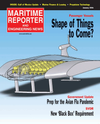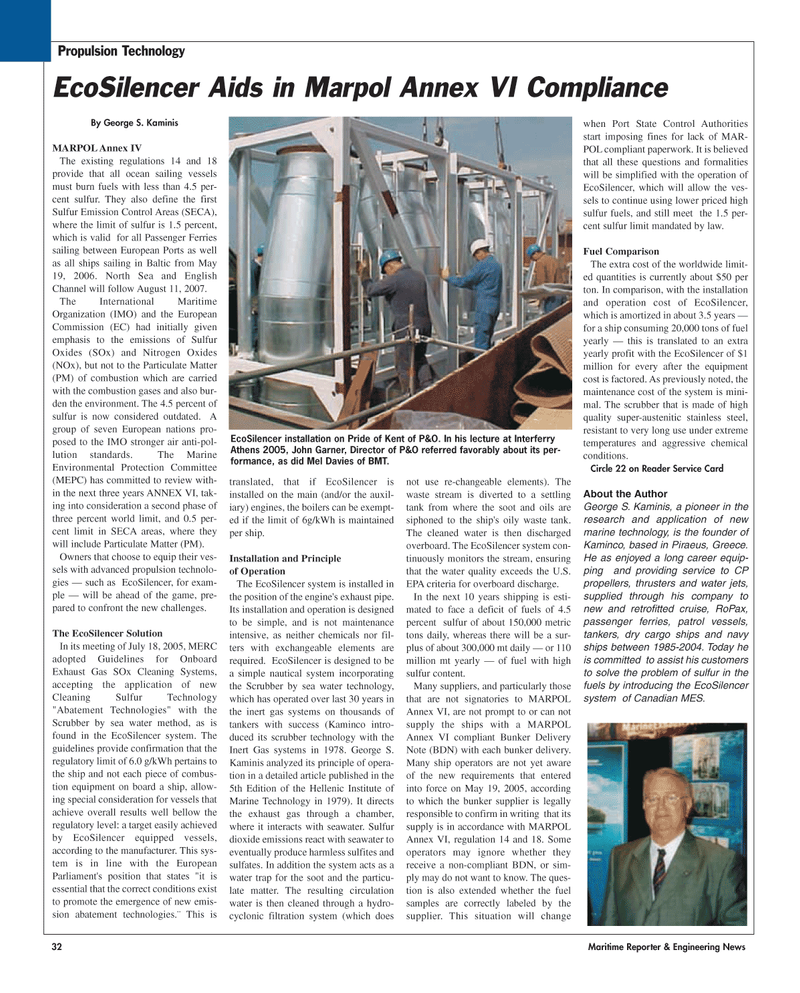
Page 32: of Maritime Reporter Magazine (January 2006)
Passenger Vessel Annual
Read this page in Pdf, Flash or Html5 edition of January 2006 Maritime Reporter Magazine
32 Maritime Reporter & Engineering News
By George S. Kaminis
MARPOL Annex IV
The existing regulations 14 and 18 provide that all ocean sailing vessels must burn fuels with less than 4.5 per- cent sulfur. They also define the first
Sulfur Emission Control Areas (SECA), where the limit of sulfur is 1.5 percent, which is valid for all Passenger Ferries sailing between European Ports as well as all ships sailing in Baltic from May 19, 2006. North Sea and English
Channel will follow August 11, 2007.
The International Maritime
Organization (IMO) and the European
Commission (EC) had initially given emphasis to the emissions of Sulfur
Oxides (SOx) and Nitrogen Oxides (NOx), but not to the Particulate Matter (PM) of combustion which are carried with the combustion gases and also bur- den the environment. The 4.5 percent of sulfur is now considered outdated. A group of seven European nations pro- posed to the IMO stronger air anti-pol- lution standards. The Marine
Environmental Protection Committee (MEPC) has committed to review with- in the next three years ANNEX VI, tak- ing into consideration a second phase of three percent world limit, and 0.5 per- cent limit in SECA areas, where they will include Particulate Matter (PM).
Owners that choose to equip their ves- sels with advanced propulsion technolo- gies — such as EcoSilencer, for exam- ple — will be ahead of the game, pre- pared to confront the new challenges.
The EcoSilencer Solution
In its meeting of July 18, 2005, MERC adopted Guidelines for Onboard
Exhaust Gas SOx Cleaning Systems, accepting the application of new
Cleaning Sulfur Technology "Abatement Technologies" with the
Scrubber by sea water method, as is found in the EcoSilencer system. The guidelines provide confirmation that the regulatory limit of 6.0 g/kWh pertains to the ship and not each piece of combus- tion equipment on board a ship, allow- ing special consideration for vessels that achieve overall results well bellow the regulatory level: a target easily achieved by EcoSilencer equipped vessels, according to the manufacturer. This sys- tem is in line with the European
Parliament's position that states "it is essential that the correct conditions exist to promote the emergence of new emis- sion abatement technologies.¨ This is translated, that if EcoSilencer is installed on the main (and/or the auxil- iary) engines, the boilers can be exempt- ed if the limit of 6g/kWh is maintained per ship.
Installation and Principle of Operation
The EcoSilencer system is installed in the position of the engine's exhaust pipe.
Its installation and operation is designed to be simple, and is not maintenance intensive, as neither chemicals nor fil- ters with exchangeable elements are required. EcoSilencer is designed to be a simple nautical system incorporating the Scrubber by sea water technology, which has operated over last 30 years in the inert gas systems on thousands of tankers with success (Kaminco intro- duced its scrubber technology with the
Inert Gas systems in 1978. George S.
Kaminis analyzed its principle of opera- tion in a detailed article published in the 5th Edition of the Hellenic Institute of
Marine Technology in 1979). It directs the exhaust gas through a chamber, where it interacts with seawater. Sulfur dioxide emissions react with seawater to eventually produce harmless sulfites and sulfates. In addition the system acts as a water trap for the soot and the particu- late matter. The resulting circulation water is then cleaned through a hydro- cyclonic filtration system (which does not use re-changeable elements). The waste stream is diverted to a settling tank from where the soot and oils are siphoned to the ship's oily waste tank.
The cleaned water is then discharged overboard. The EcoSilencer system con- tinuously monitors the stream, ensuring that the water quality exceeds the U.S.
EPA criteria for overboard discharge.
In the next 10 years shipping is esti- mated to face a deficit of fuels of 4.5 percent sulfur of about 150,000 metric tons daily, whereas there will be a sur- plus of about 300,000 mt daily — or 110 million mt yearly — of fuel with high sulfur content.
Many suppliers, and particularly those that are not signatories to MARPOL
Annex VI, are not prompt to or can not supply the ships with a MARPOL
Annex VI compliant Bunker Delivery
Note (BDN) with each bunker delivery.
Many ship operators are not yet aware of the new requirements that entered into force on May 19, 2005, according to which the bunker supplier is legally responsible to confirm in writing that its supply is in accordance with MARPOL
Annex VI, regulation 14 and 18. Some operators may ignore whether they receive a non-compliant BDN, or sim- ply may do not want to know. The ques- tion is also extended whether the fuel samples are correctly labeled by the supplier. This situation will change when Port State Control Authorities start imposing fines for lack of MAR-
POL compliant paperwork. It is believed that all these questions and formalities will be simplified with the operation of
EcoSilencer, which will allow the ves- sels to continue using lower priced high sulfur fuels, and still meet the 1.5 per- cent sulfur limit mandated by law.
Fuel Comparison
The extra cost of the worldwide limit- ed quantities is currently about $50 per ton. In comparison, with the installation and operation cost of EcoSilencer, which is amortized in about 3.5 years — for a ship consuming 20,000 tons of fuel yearly — this is translated to an extra yearly profit with the EcoSilencer of $1 million for every after the equipment cost is factored. As previously noted, the maintenance cost of the system is mini- mal. The scrubber that is made of high quality super-austenitic stainless steel, resistant to very long use under extreme temperatures and aggressive chemical conditions.
Circle 22 on Reader Service Card
About the Author
George S. Kaminis, a pioneer in the research and application of new marine technology, is the founder of
Kaminco, based in Piraeus, Greece.
He as enjoyed a long career equip- ping and providing service to CP propellers, thrusters and water jets, supplied through his company to new and retrofitted cruise, RoPax, passenger ferries, patrol vessels, tankers, dry cargo ships and navy ships between 1985-2004. Today he is committed to assist his customers to solve the problem of sulfur in the fuels by introducing the EcoSilencer system of Canadian MES.
Propulsion Technology
EcoSilencer Aids in Marpol Annex VI Compliance
EcoSilencer installation on Pride of Kent of P&O. In his lecture at Interferry
Athens 2005, John Garner, Director of P&O referred favorably about its per- formance, as did Mel Davies of BMT.
MR JANUARY2006 #4 (25-32).qxd 1/3/2006 3:37 PM Page 32

 31
31

 33
33
